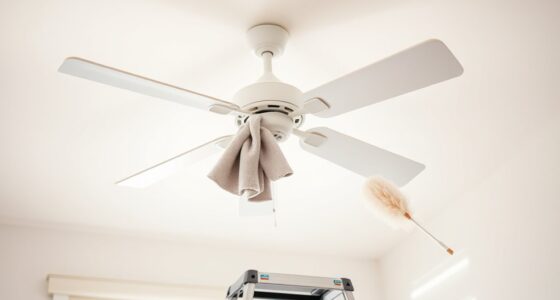Smart remote controls for ceiling fans offer great convenience by letting you operate fans effortlessly via voice commands or smartphone apps, reducing clutter and hassle. They often include features like scheduling, timers, and remote access, making your life easier. While setup can be a bit complex and compatibility needs checking, their sleek design helps you stay organized. If you want to discover how these devices can streamline your space and simplify your routines, there’s more to explore.
Key Takeaways
- Smart remote controls offer convenient control via voice or smartphone, enhancing comfort and ease of use.
- They reduce clutter by replacing traditional remotes, but multiple devices can add to space concerns.
- Energy-efficient design minimizes battery replacements, supporting long-term usability and less waste.
- Compatibility and setup complexity may cause initial inconvenience, but ease of control improves user experience.
- Proper organization and modern designs prevent remotes from becoming clutter, balancing convenience with space management.

Have you ever wished you could adjust your ceiling fan without getting up? That’s where remote controls come into play, offering unmatched convenience. But as technology advances, many remote controls now feature smart integration, allowing you to connect your ceiling fan to your smart home system. With this integration, you can control your fan through voice commands or smartphone apps, making it effortless to adjust settings from anywhere in the room or even remotely. Imagine sitting on your couch, telling your smart assistant to turn the fan on or change its speed—no more reaching for a switch or remote. This seamless connectivity enhances comfort and simplifies daily routines, especially when your hands are full or you’re lying in bed. However, with all these smart features, battery longevity becomes a vital factor. Many remote controls rely on batteries, and frequent replacements can become a hassle. Thankfully, manufacturers are now designing remotes with energy-efficient components and low-power Bluetooth or Wi-Fi modules, which extend battery life considerably. Some models even incorporate rechargeable batteries, reducing waste and ongoing costs. Knowing your remote has a long battery life means fewer interruptions and less worry about losing power when you need it most.
While smart integration offers incredible convenience, it also introduces some considerations. You need to verify your remote’s compatibility with your smart home system, which can sometimes involve a learning curve. But once set up, controlling your ceiling fan becomes as easy as tapping your phone or speaking aloud. Additionally, many smart remotes have features like timers, scheduling, or automation options, giving you even more control over your environment. For example, some models are compatible with appliance labs testing standards to ensure reliability. On the other hand, some users worry that adding more gadgets might clutter their space or complicate their setup. That’s a valid concern, but modern remote controls are designed to be sleek, unobtrusive, and easy to store when not in use. The key is to balance the benefits of smart integration with your personal preferences for simplicity.
Frequently Asked Questions
How Do I Program a Universal Ceiling Fan Remote?
To program a universal ceiling fan remote, start with the programming steps outlined in your remote’s manual. Make certain your remote compatibility matches your fan model. Usually, you’ll press and hold specific buttons to enter learning mode, then sync the remote with your fan by pressing the fan’s reverse or power button. Follow the instructions carefully to guarantee proper pairing, making your remote functional and eliminating clutter.
Can Remote Controls Interfere With Other Electronic Devices?
Did you know that nearly 30% of electronic device malfunctions are caused by electromagnetic interference? Your remote controls can interfere with other devices through signal disruption, especially if they operate on similar frequencies like 2.4 GHz. To avoid issues, keep remotes away from sensitive electronics and make sure your devices are properly shielded. This helps prevent electromagnetic interference and maintains smooth operation across all your gadgets.
What Should I Do if My Remote Stops Working?
When your remote stops working, try remote troubleshooting first by replacing the batteries and ensuring nothing obstructs the signal. If it still doesn’t work, consider replacement options like buying a new remote compatible with your fan. You might also check if the remote’s sensor or receiver is damaged. If troubleshooting doesn’t help, contacting the manufacturer for guidance or a replacement can save you time and frustration.
Are There Energy-Saving Benefits to Using Remote Controls?
Using remote controls for your ceiling fan can boost energy efficiency by allowing you to turn the fan on or off precisely when needed, reducing unnecessary power consumption. They help you manage airflow more effectively, preventing wasteful operation. By adjusting settings remotely, you avoid leaving the fan running when not in use, ultimately lowering overall power consumption and helping you save on energy costs.
How Secure Are Smart Ceiling Fan Remote Controls From Hacking?
Smart ceiling fan remote controls can be vulnerable to hacking, but their security depends on wireless encryption. If they use strong encryption protocols, hacking vulnerabilities are minimized, making them fairly secure. However, weaker encryption or outdated firmware can leave you exposed. To safeguard yourself, regularly update your device’s software and choose models with robust wireless encryption. Staying vigilant ensures your smart fan remains a convenient, secure addition to your home.
Conclusion
So, next time you’re fumbling for your remote amid a sea of clutter, remember: that tiny device promises convenience but often feels more like a mischievous intruder. You’re left wondering if the breeze from your fan is worth the chaos of lost remotes and tangled cords. Ironically, what’s meant to simplify your life may just turn your living room into a cluttered playground. Sometimes, the simplest solutions are the ones you forget to contemplate.









